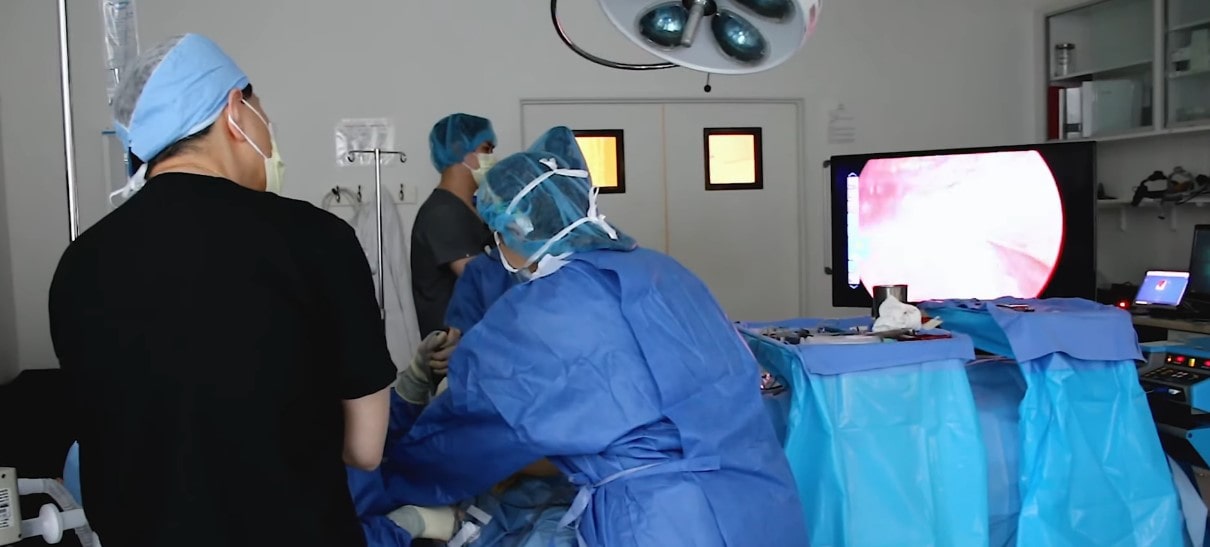
Many people choose to get facelifts as they get older to tighten and smooth their aging skin. As technology advances, there are many types of facelifts available beyond the traditional facelift that most people are familiar with.
Have you considered an endoscopic facelift? For those who are nervous about scarring and long recovery time, a traditional facelift might seem scary. That’s where the endoscopic facelift comes in. Keep reading to learn all about endoscopic facelifts so you can make an informed decision about your next cosmetic procedure.
When considering new facial rejuvenation techniques, it is crucial to thoroughly explore the available options and understand their differences.
So what is an endoscopic facelift anyway, and why would someone choose it over a traditional facelift?
First, let’s talk about traditional facelifts. A traditional facelift is a tried-and-true method of pulling back and tightening skin in such a way that wrinkles, sagging skin, and lines are softened.
In a traditional facelift procedure, a surgeon makes an incision that goes along the hairline to pull some of the skin back towards the ears and redistribute the underlying layer of fat. The surgeon may re-contour the face by adjusting sub-dermal muscles before suturing the skin closed. While this is an effective procedure, it’s also an invasive one, and it can leave visible scarring.
Endoscopic facelifts are different. The endoscopic lift is a minimally invasive, facial rejuvenation procedure that targets sagging muscles and excess fatty deposits for a youthful appearance. For this procedure, surgeons use endoscopes (tiny cameras used in surgery) to see underneath the skin. This allows them to get a clear idea of what the tissue and muscles look like without open surgery. Instead of removing or pulling excess skin, an endoscopic facelift tightens muscles and manages excess fatty deposits to give the face a smoother and tighter look.
See more results in our Before & After gallery!
The field of facial plastic surgery has been revolutionized by the introduction of a fiber-optic endoscope, presenting a novel approach that can provide a multitude of advantages compared to traditional facelifts.
Using a fiber-optic endoscopic makes an endoscopic facelift a less invasive procedure than a traditional facelift. The endoscopic technique provides patients with several benefits, including:
An endoscopic facelift allows a surgeon to address the underlying facial structures that contribute to sagging or drooping facial features while minimizing the bruising and swelling that occur after the procedure.
An endoscopic facelift can be highly effective for men and women who are concerned about moderate signs of facial aging. Ideal candidates are:
Candidates for endoscopic facelifts usually range in age from their early 30s to their late 50s. Surgical candidates should also be in good overall health.
The procedure targets the upper and the middle third of the face and can improve issues including:
During the consultation, your surgeon will evaluate your facial structure and determine whether an endoscopic facelift would be more effective in accomplishing your aesthetic goals.
Endoscopic Mid Facelift Results. See more in our Before & After gallery!
As with any cosmetic procedure, you’ll start with a consultation. During the evaluation, the patient’s face and neck will be carefully evaluated from a variety of different angles.
The surgeon will perform an assessment of the laxity and redundancy of the skin and soft tissues at many different locations of the face and neck in order to determine where they could be tightened. The location of the temporal hairline and sideburn is also evaluated to determine the ideal placement of the surgical incisions.
The facial skeleton is evaluated to determine whether its modification would enhance the overall result of the endoscopic facelift. This could be achieved by:
A surgeon will also perform an assessment as to whether the aesthetic result of the facelift could be improved by performing complementary procedures like:
The doctor will also make an assessment as to whether, in addition to lifting and tightening the patient’s skin and soft tissues, the aesthetic result of the endoscopic facelift could be improved by increasing the volume of soft tissue in the face by fat transfer. The areas the face where these fat transfers are most commonly performed are:
Once you have your actual facelift scheduled, your doctor may give you special instructions on how to prepare. These may include how long you should fast before your procedure, if you should schedule someone to pick you up from the surgical center, and if you should take special precautions for skincare before the facelift.
The doctors at Wave Plastic Surgery are industry leaders in Endoscopic Surgery. Don’t wait to schedule your consultation with a skilled and experienced Wave Plastic Surgeon.
On the day of your procedure, you will be placed under general anesthesia. The process can take anywhere from two to five hours, depending on the extensiveness procedure, and if any other adjunctive procedures are being performed at the same time.
To begin, the surgeon will make several tiny incisions behind the ears and behind the hairline. The exact location of the incisions will vary depending on each patient’s anatomy, tissues, and surgical goals. Generally, the incision begins in the lower temple, behind the hairline, and continues down to the skin just in front of the earlobe. Patients who require more attention in the neck area will also receive a counter-incision under the chin. This placement minimizes the length requirement of the incisions and helps them to be camouflaged when they heal.
The camera of an endoscope allows for a magnified image of the surgical field to be projected onto a large LED screen in the operating theater. The surgeon will use miniaturized instruments that can then be introduced under endoscopic guidance. This allows the surgeon to nimbly and precisely maneuver within this small space, preserving vital structures while making adjustments.
Once the adjustments have been made, the SMAS (superficial musculoaponeurotic system, i.e., the covering of the facial musculature) flaps are secured in their newly elevated position with a series of precisely placed sutures. The excess skin and soft tissue can then be removed.
The limited incisions are then closed in a series of layers to ensure optimal healing and an inconspicuous scar. The portion of the incision in the scalp is closed with stainless steel surgical staples.

After the procedure is over, the surgeon will cover your face in a post-operative garment or bandages. These will be changed on the patient’s first postoperative visit the day after surgery. The surgical staples in the scalp will be removed one week after the surgery. The skin sutures can be removed one week later.
For the first two weeks, you need to be gentle with your face and skin. Make sure to avoid too much neck or jaw movement and take all of your prescribed medications. The patient’s face will feel tight, and look somewhat swollen in the first few days after surgery. By the time all of the staples and sutures have been removed, the patient will be able to appreciate the early results of their rejuvenation.
Patients are usually able to move around with assistance even on the first night of the surgery, and certainly by the next day. They can usually return to work within two weeks of the surgery. A modified exercise regimen can be resumed within a month of surgery, with a transition to a full workout about six weeks after surgery.
If you have any concerns, feel free to consult with your doctor.
Endoscopic Facelift and Brow Lift Results. See more in our Before & After gallery!
If you want a facelift procedure, you may want to consider an endoscopic facelift over a traditional facelift. The quicker recovery period, minimal scarring, and faster procedure all combine to make an endoscopic facelift an appealing choice.
You can get a more youthful look. Are you ready for it?
If you’re interested in an endoscopic facelift, it’s time to contact us. Our experienced plastic surgeons are ready to give you the look that you’ve always wanted. Schedule a consultation today!
Give us a call today to schedule a consultation with one of the plastic surgery experts at Wave Plastic Surgery to learn more about the procedure and the thread face lift cost.
In order to achieve a more youthful appearance, an endoscopic facelift tightens and reshapes your underlying facial muscles and tissue.
It can take 2-3 hours for an endoscopic facelift, depending on its complexity. The surgery time will vary when combined with other procedures, such as a neck lift. During the procedure, you will be given an anesthetic so that you will not feel any pain.
Because it is less invasive, an endoscopic facelift leaves minimal or no scarring, and complications are reduced.
It’s important to consider the overall value and quality of the treatment rather than solely focusing on the endoscopic facelift price. When it comes to how much an endoscopic facelift costs can vary between $5,000 to $12,000, depending on factors such as the surgeon’s expertise and location.
Most patients can return to work 2 weeks after a Facelift Surgery. This timeline allows for an adequate healing period, during which the effects of postoperative swelling and bruising subside, and the incision sites continue to heal.
You may need a facelift if you are not pleased with the signs of aging on your face and you are otherwise in good health. If you are bothered by sagging, excess skin in the face, and neck you may want to consult a plastic surgeon.
For men and women in their 30s, 40s, or 50s with moderate signs of facial aging but without large amounts of sagging skin, an endoscopic facelift can be highly effective.
The surgery can make patients look up to ten years younger than their actual age, and the results last for a long time. To fully appreciate the remarkable reconstruction transformation, it’s helpful to compare the endoscopic facelift before and after results.
Endoscopic facelifts remove excess fat and tighten muscles in the lower portion of the face and neck. When performed by an experienced Plastic Surgeon, the result will look natural. Endoscopic facelifts are not designed to pull the skin so tight that they cause the corners of your mouth to spread.
In order to achieve a more youthful appearance, an endoscopic facelift tightens and reshapes your underlying facial muscles and tissue. Frown lines between the eyes and Marionette lines can be improved with this procedure, which targets the upper and middle third of the face.
By the fifth week following your surgery, you should be able to resume some of your normal exercise routine. It is still not recommended to lift heavy objects or run strenuously, but light jogging and stretching are okay.
Don’t settle for the ‘endoscopic facelift near me’ you find in generic search results. For expert care and personalized consultation contact Wave Plastic Surgery & Laser Center.
Give us a call today to schedule your Endoscopic Facelift consultation with one of our plastic surgeons located in Los Angeles, Orange County, and San Francisco.